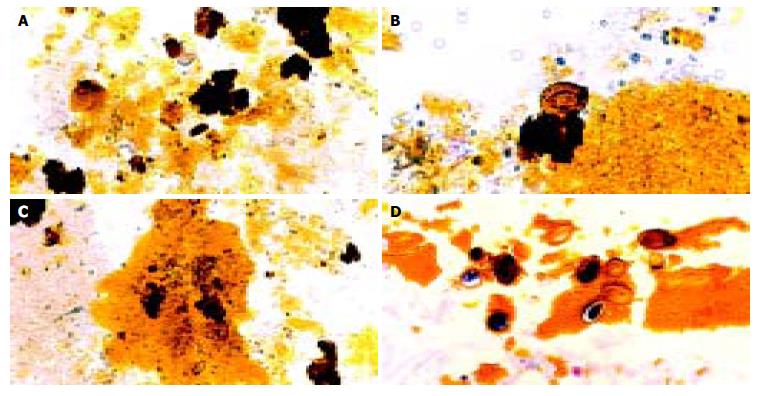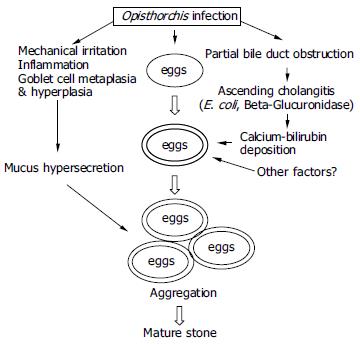Copyright
©The Author(s) 2004.
World J Gastroenterol. Nov 15, 2004; 10(22): 3318-3321
Published online Nov 15, 2004. doi: 10.3748/wjg.v10.i22.3318
Published online Nov 15, 2004. doi: 10.3748/wjg.v10.i22.3318
Figure 1 Histochemical staining of biliary sludge for bilirubin (A) and calcium (B).
Calcium appears as dark deposits on the Opisthorchis eggshell (arrow) and bilirubin precipitates are demonstrated in the outer layer (arrowhead). Normal parasite eggs without deposition are shown in the same field. (A = Fouchet stain, B = von Kossa stain).
Figure 2 Typical pictures showing the cascades of Opisthorchis egg-associated stone formation starting from aggregation of the eggs admixed with mucin (A), deposition of calcium bilirubinate on the eggshells (B), and formation of tiny stones (C & D).
Original magnification, × 100 (A & C) and × 200 (B & D).
Figure 3 SEM micrographs of gallstones showing Opisthorchis eggs with typical musk-melon-eggshell surface in the nidi of the stones.
Several crystalline structures consistent with calcium (Ca), bilirubin derivatives (Bi) and cholesterol (Ch) could be noted (A, B). Higher magnification with highlighting calcium bilirubinate deposition on Opisthorchis eggshell and mucus is shown in Figure 3B.
Figure 4 Diagram showing the proposed pathogenesis of Opisthorchis-associated biliary stone.
- Citation: Sripa B, Kanla P, Sinawat P, Haswell-Elkins MR. Opisthorchiasis-associated biliary stones: Light and scanning electron microscopic study. World J Gastroenterol 2004; 10(22): 3318-3321
- URL: https://www.wjgnet.com/1007-9327/full/v10/i22/3318.htm
- DOI: https://dx.doi.org/10.3748/wjg.v10.i22.3318












